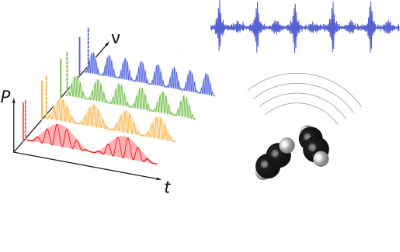Photo-acosutic dual-comb spectroscopy
Dual-optical frequency combs interact with molecules to produce a characteristic acoustic fingerprint signal. This novel technique of dual-frequency comb photo-acoustic spectroscopy can overcome the challenges of mid-infrared light detection and be used for sensitive, rapid and broadband sensing of molecular species, even in microscopic samples.
Photo-acoustic spectroscopy (PAS) is a powerful technique to analyze gases, fluids and solids. It can be used with microscopic and even non-transparent samples and owing to its background-free nature PAS is highly sensitive. In our work, we show that the advantages of PAS can be combined with the unmatched precision, speed and wavelength coverage that is offered by dual-frequency comb spectroscopy (DCS). Illuminating the sample with dual-optical frequency combs, the molecular absorption spectrum is probed simultaneously at multiple optical wavelengths. The absorption strength at each of these wavelengths is encoded in a characteristic acoustic signal that can be detected by a microphone (overcoming the challenge of mid-infrared photodetection). This novel technique of dual-frequency comb photo-acoustic spectroscopy (DCPAS) could be used for trace gas sensing and potentially opens new avenues for rapid and broadband molecular sensing (e.g. in environmental monitoring, microscopy and chemical analysis).

Illustration of photo-acoustic dual-comb spectroscopy.
Reference:
Photo-acoustic dual-frequency comb spectroscopy; Thibault Wildi, Thibault Voumard, Victor Brasch, Gürkan Yilmaz, Tobias Herr; Nature Communications, 2020; DOI: 10.1038/s41467-020-17908-9